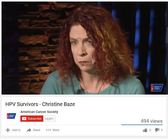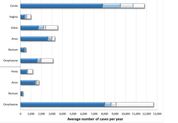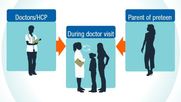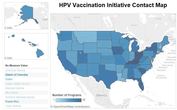We have an amazing
tool to protect young people from most of the cancers caused by HPV, including
cervical cancer. Let’s use the rest of January to raise awareness of all HPV
cancers and HPV vaccination.
CDC and several
partner organizations have compiled a multitude of resources for the new HPV Vaccination Partner Toolkit that can help you share the importance of HPV vaccination, help clinicians make effective recommendations, improve coverage rates, and provide you with places you can go to get more information and materials. Below are ways you can raise awareness this month and in the future.
Share Why HPV Vaccine is Important
 |
1. Have
Survivors Come to Speak
Having a survivor come speak to clinicians in the area can make a big impact. The American Cancer Society has developed a speaker database that will allow you to find HPV cancer survivors in your area. |
 |
2. Share Survivor
Videos
HPV cancer survivors have a unique and powerful story to tell. Listen to these men and women talk about their experiences important. These videos can be used to help parents and clinicians understand the risks of HPV infection and why HPV vaccination is so important. |
 |
3. Set up a viewing of
Someone You Love
“Someone You Love: The HPV Epidemic” is a feature length in-depth documentary narrated by Vanessa Williams on the human papilloma virus (HPV) and the stories of struggle, tragedy and triumph surrounding this complicated and often misunderstood infection. |
 |
4. Discover the Link Between HPV and Cancer
Each year, about 38,793 new cases of cancer are found in parts of the body where human papillomavirus (HPV) is often found. HPV causes about 30,700 of these cancers. Get the statistics around HPV and Cancer from CDC to better understand the burden of HPV infection. |
 |
1. Share the Updated
Clinician Factsheet
Our updated clinician tipsheet highlights the use of the "bundled recommendation" and gives simple and effective answers to the questions parents have about HPV vaccine. |
 |
2. Learn How to Give an Effective Recommendation
CDC has created multiple CME courses on the best ways to give an HPV vaccine recommendation. Each course can be used to get new insight on how to have the HPV vaccine conversation with parents of 11-12 year olds and how to answer their questions. |
 |
3. Watch Providers
Giving Effective Recommendations
Minnesota Department of Health has created a 12-minute video for health care providers on HPV vaccine communication. The video begins with humorous vignettes and then presents four model clinical encounters in which providers demonstrate low-stress ways of recommending HPV vaccine and answering questions from patients and parents. |
 |
1. Know the Many Ways You Can Help
Get tips on what different types of groups can do to help raise rates. This PDF includes suggestions like: sending letters to parents of 9-12 year olds, hosting lunch and learns, working with local cancer groups, reaching out to local health systems, and more. |
 |
2. Understand
your Rates
Access survey data collected by CDC and translate the data into action. This data can help you identify where additional efforts are needed to increase vaccination coverage. |
 |
3. Get Involved
in Quality Improvement Projects
Quality improvement actions in your practice can lead to increases in HPV vaccination coverage. Find out more about the different types of quality improvement projects that are available, including AFIX visits, reminder/recall, immunization information systems, and more. |
 |
4. Participate
in A Maintenance of Certification Project
Be a part of AAP's maintenance of certification program. AAP's MOC site is designed to assist eligible AAP Member pediatricians in developing, submitting, and managing a MOC related activity. |
 |
1. CDC's HPV Partner
Toolkit
This toolkit provides resources for state and local organizations interested in enhancing HPV vaccination efforts at the clinician, patient, and partnership level. It includes all of CDC's resources for helping to promote HPV vaccine and give links to partner information. |
 |
2. The American Cancer Soceity
The American Cancer Society has several HPV vaccination rate improvement initiatives. The HPV VACs project partners with Federally Qualified Health Centers (FQHCs), state health departments, and other state-based entities to increase HPV vaccination rates through improved clinician education and systems change. The National HPV Vaccination Roundtable, coordinated by the American Cancer Society is a national coalition of over 70 national organizations working together to prevent HPV cancer and precancer by increasing and sustaining HPV vaccination rates in the United States.. |
 |
3. The AAP's
HPV Champion Toolkit.
This toolkit from the American Academy of Pediatrics has some of the best resources available to help you educate other healthcare professionals, discuss HPV vaccination with parents, and make necessary changes in your practice to improve HPV vaccination rates. |
 |
4. Local Partners
Many organizations have local initiatives to increase HPV vaccination rates. Use this page to find your state contacts, as well as information on several partner projects dedicated to preventing HPV cancers and diseases. |

